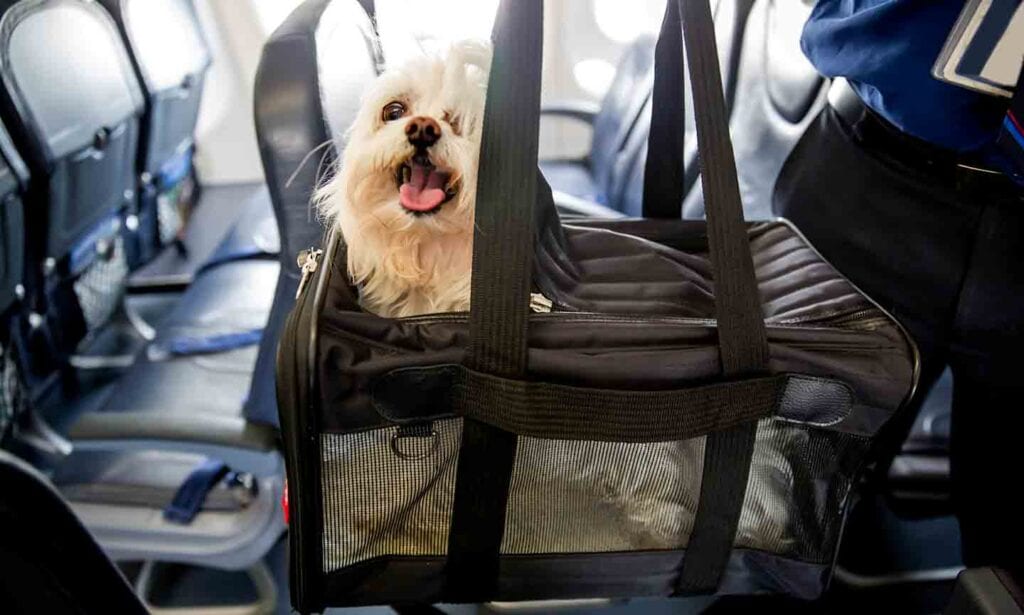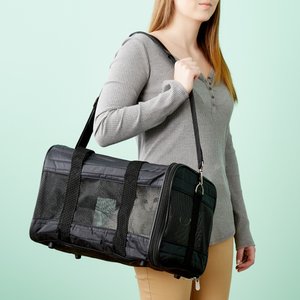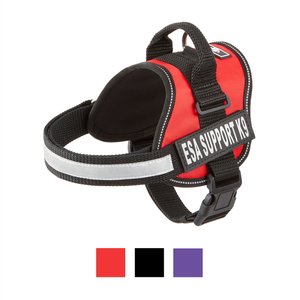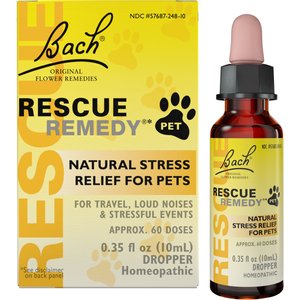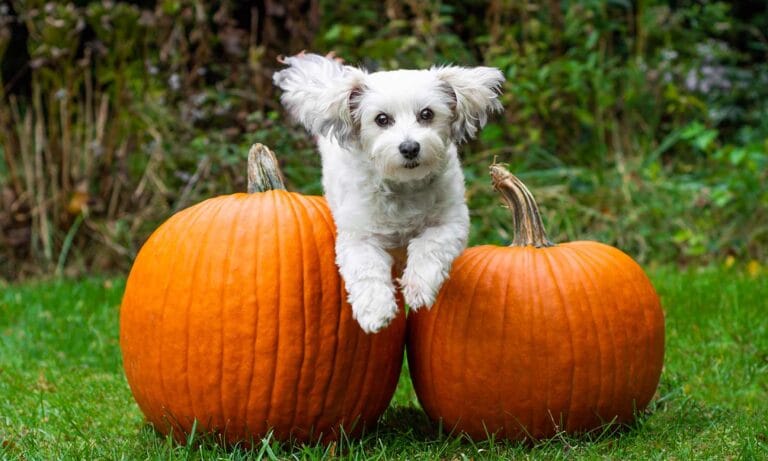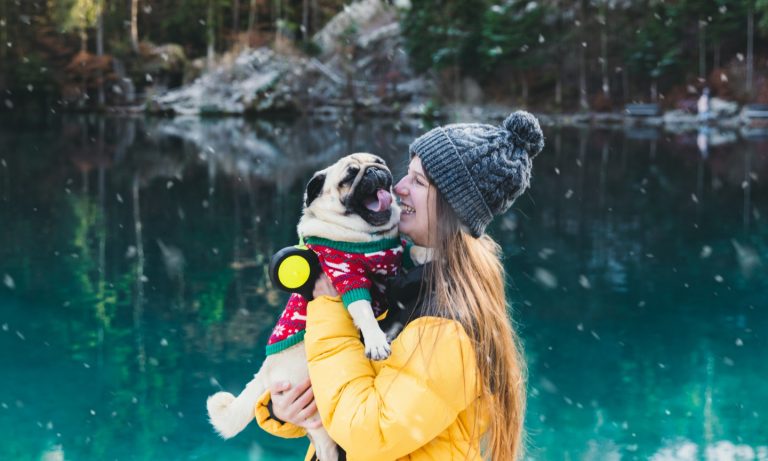In This Guide:
How To Fly With Pets
When traveling with your pet, you have two options—in cabin or cargo hold. Pets who travel in cabin are in the custody of their pet parents, while pets traveling in the cargo hold are in the airline’s custody.
Each airline has its pet policies, but, in general, only small dogs and cats can travel with their pet parents in cabin. If you’re wondering what size dog can fly in cabin, the typical rule is that the pet will need to remain in a soft-sided container the entire flight—and this container needs to fit underneath the seat directly in front of you. Unfortunately, your dog cannot sit in your lap on the plane.
Larger pets will travel in the cargo hold area, and each airline has its own specific policies. However, some airlines, such as Southwest, JetBlue, and Spirit, will not transport pets in the cargo hold. Certain brachycephalic breeds (including dogs such as Pugs and Boxers and cats such as Persians and Himalayans) should not fly in the cargo hold, because they are at higher risk of breathing issues.
According to Nelva J. Bryant, DVM, MPH, an airline industry veterinarian and pet travel expert based in Atlanta, Georgia, if your pet is well-prepared to travel and has been medically cleared by their veterinarian, it is safe to fly in the cargo hold.
Should I Fly With My Pet?
You’re headed on vacation and want to take your furry friend along on the flight. So, how hard is it to fly with a pet?
The answer to that question depends a lot on where you’re headed. If you’re flying within the United States, you may need documentation (also known as a health certificate) or you may not. For example, a trip to Hawaii, which is a rabies-free state, requires specific paperwork.
International pet travel requires more extensive documentation. Depending on your destination, gathering all the required paperwork could take up to a year.
Even if you can get all the required certifications together, you’ll want to consider how stressful flying might be for your pet. Dr. Bryant recommends pet parents consider their dog or cat’s comfort first. Ask yourself:
- Does my pet do well in new places?
- Will they enjoy being around crowds of strangers?
- Do they get anxious or upset easily, such as when traveling in the car?
While some pets love following their pet parents wherever they go, others should be left safely at home when the family travels.

How Much Does It Cost To Fly With a Pet?
Depending on your airline, pet fees range from $95 to $150 for domestic flights. The price is higher for domestic destinations outside the continental United States and international flights. By federal law, service dogs fly for free.
Pet-Friendly Airlines
While almost all major U.S. airlines allow pets, they have different policies. According to Lindsay Douglas, a travel agent in Kansas City, Missouri, her clients prefer traveling on Southwest because of some of their pet-friendly policies.
Here is information on some of the major carriers, so you can choose based on your pet’s unique needs:
Alaska Airlines
$100–$150
Dogs, cats, rabbits, and birds
Only dogs and cats can travel to Hawaii and international destinations in the main cabin.
American Airlines
$150
Dogs and cats
Pets cannot be checked as cargo unless traveling with active-duty military personnel or State Department employees.
Delta Airlines
$95
Dogs, cats, and birds
Birds are only permitted on domestic flights, excluding flights to Hawaii, U.S. Virgin Islands, Puerto Rico, and Guam.
Frontier Airlines
$99
Dogs, cats, rabbits, guinea pigs, hamsters, and birds
Does not allow pets to be checked as cargo.
JetBlue Airways
$125
Dogs and cats
Does not allow pets to be checked as cargo. Only one pet per customer.
Southwest Airlines
$125
Dogs and cats
Does not allow pets on flights to or from Hawaii or international destinations. Does not allow pets to be checked as cargo.
Spirit Airlines
$125
Dogs, cats, and birds
Pets are not allowed to be checked as cargo or in the cabin on international flights (except service animals).
United Airlines
$150
Dogs and cats
Pets cannot be checked as cargo unless traveling with active-duty military personnel or State Department employees.
What Does My Pet Need for a Flight?
You’re ready to fly the furry skies! What will your pet need for their flight?
Pet Needs
Douglas tells her travel clients to pack a bag for their pet, similar to bringing a diaper bag for a small child. Include:
- Collar and leash
- Dog poop bags
- Dog pee pads (and any related cleaning supplies)
- Bowl for water
- Treats for your dog or cat
- Extra food (in case checked luggage gets lost)
- Medication, if your pet takes it regularly
- Toys
- Bedding
- First-aid kit
- Vaccine records, health certificate and any other necessary paperwork
Pet Carrier
You will need to purchase a pet carrier that fits your pet and meets the guidelines of the airline you’re flying on. Some pet carriers are advertised by weight, but you’ll want to look at your pet’s height, length, and width to find the right size. The International Air Transport Association (IATA) has guidelines to help you choose the best container for your pet.
If your pet is flying with you in cabin, you will need a soft-sided carry-on pet carrier that fits like a personal item underneath the seat directly in front of you. Check with your airline for specific size requirements. In general, you want to look for a pet carrier that’s well-ventilated and leak-proof. Your pet should be able to move around comfortably when the pet carrier is closed.
For cargo pet carriers, Dr. Bryant recommends avoiding anything advertised as “easy to assemble.” You want a hard-sided kennel with solid construction.”
Health Certificate
Depending on where you are traveling, you may be required to provide a health certificate for your pet. This certificate shows that your pet meets the requirements of your destination, such as having a microchip or rabies vaccinations.
If you leave the country with your pet, the Centers for Disease Control and Prevention (CDC) may require you to show additional documentation upon your return to the U.S. if your pet visited one of their designated high-risk countries.
Despite its name, a health certificate does not mean your pet is healthy to travel. Dr. Bryant recommends discussing your pet’s overall health before traveling with them. A pet with underlying health conditions (such as heart disease, diabetes, or respiratory disease) may be at risk of developing complications during a flight.

How To Prepare for Your Flight
Don’t wait until the day of your trip to try out your new pet carrier. Once you get your IATA-compliant kennel, practice crate training with your pet at home. Getting your pet used to this new space can take weeks or months, but, in the end—before traveling—the pet carrier should feel “safe” to them.
Start by leaving the pet carrier in the house with the door open so your pet can enter. You can close the door for about 30 minutes when they seem comfortable. Then, gradually work up to more extended periods. If you’re taking a five-hour flight, you’ll want them to feel comfortable in the pet carrier for over five hours. You can also take them on short trips in the carrier to get them used to traveling. Feel free to give treats, but never use the pet carrier to punish your pet.
If your pet often gets motion sickness during travel, ask your veterinarian about medications to prevent your pet from vomiting.
Departure Day Tips
The big day is finally here! Follow these tips:
- Give your pet a small meal four to six hours before your flight.
- Ensure they exercise before arriving at the airport so they are ready to rest during the flight.
- Give them a potty break before getting on board the plane.
- Keep a bowl and water with you in case they need a drink.
Thinking about sedating your dog for air travel? Discuss anti-anxiety medications and sedatives with your veterinarian first. It’s best to do a trial run with these medications at home before your trip so you know how your pet will react to them. Medications that affect the heart, lungs, and blood pressure are usually avoided for pets who are flying.
Flying With Pets FAQs
Q:How old do my pets have to be to fly?
A:This depends on the airline and destination. Most major airlines require a pet to be at least 8 weeks old, but you should check for individual guidelines. Different destinations may also have specific rules. Per the CDC, dogs must be at least 6 months old to enter the United States.
Q:How do dogs pee on flights?
A:Ideally, they don’t. But if you’re worried your pup will have an accident, you can line their carrier with absorbent pads. Bring other cleaning supplies—gloves, wipes, and plastic bags—for in-flight cleanup.
Q:How are pets cared for on long flights?
A:According to the USDA, dogs and cats traveling under the care of an airline should be offered food (every 24 hours) and water (every 12 hours) on long trips. They should also be protected from extreme temperatures and weather and not come into contact with other animals.
Q:How are dogs loaded on planes?
A:For pets traveling in the cargo hold, after check-in, they will be loaded into the belly of the plane. They are generally the last cargo to be loaded and the first off. Many airlines will not allow your pet to fly in the cargo hold if temperatures are too hot or too cold, so be aware when booking your flight.
Q:Can my pet walk around the airport?
A:Typically, they can. Many major airports have amenities like a pet relief area, grooming services, or pet-friendly lounges. Check with your airport in advance to fully understand their rules and amenities for pets.
More Pet Travel Tips
Share:
